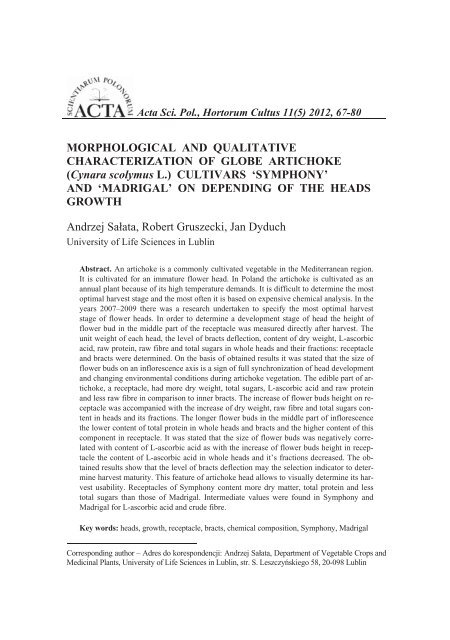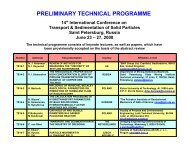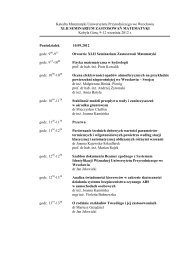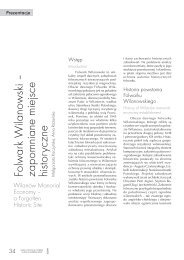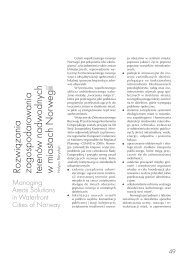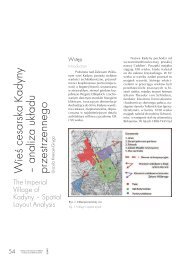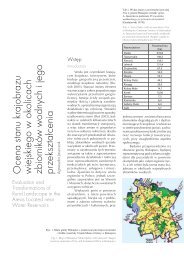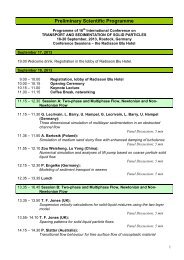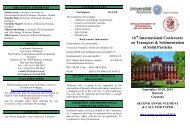(Cynara scolymus L.) CULTIVARS 'SYMPHONY'
(Cynara scolymus L.) CULTIVARS 'SYMPHONY'
(Cynara scolymus L.) CULTIVARS 'SYMPHONY'
Create successful ePaper yourself
Turn your PDF publications into a flip-book with our unique Google optimized e-Paper software.
Acta Sci. Pol., Hortorum Cultus 11(5) 2012, 67-80<br />
MORPHOLOGICAL AND QUALITATIVE<br />
CHARACTERIZATION OF GLOBE ARTICHOKE<br />
(<strong>Cynara</strong> <strong>scolymus</strong> L.) <strong>CULTIVARS</strong> ‘SYMPHONY’<br />
AND ‘MADRIGAL’ ON DEPENDING OF THE HEADS<br />
GROWTH<br />
Andrzej Saata, Robert Gruszecki, Jan Dyduch<br />
University of Life Sciences in Lublin<br />
Abstract. An artichoke is a commonly cultivated vegetable in the Mediterranean region.<br />
It is cultivated for an immature flower head. In Poland the artichoke is cultivated as an<br />
annual plant because of its high temperature demands. It is difficult to determine the most<br />
optimal harvest stage and the most often it is based on expensive chemical analysis. In the<br />
years 2007–2009 there was a research undertaken to specify the most optimal harvest<br />
stage of flower heads. In order to determine a development stage of head the height of<br />
flower bud in the middle part of the receptacle was measured directly after harvest. The<br />
unit weight of each head, the level of bracts deflection, content of dry weight, L-ascorbic<br />
acid, raw protein, raw fibre and total sugars in whole heads and their fractions: receptacle<br />
and bracts were determined. On the basis of obtained results it was stated that the size of<br />
flower buds on an inflorescence axis is a sign of full synchronization of head development<br />
and changing environmental conditions during artichoke vegetation. The edible part of artichoke,<br />
a receptacle, had more dry weight, total sugars, L-ascorbic acid and raw protein<br />
and less raw fibre in comparison to inner bracts. The increase of flower buds height on receptacle<br />
was accompanied with the increase of dry weight, raw fibre and total sugars content<br />
in heads and its fractions. The longer flower buds in the middle part of inflorescence<br />
the lower content of total protein in whole heads and bracts and the higher content of this<br />
component in receptacle. It was stated that the size of flower buds was negatively correlated<br />
with content of L-ascorbic acid as with the increase of flower buds height in receptacle<br />
the content of L-ascorbic acid in whole heads and it’s fractions decreased. The obtained<br />
results show that the level of bracts deflection may the selection indicator to determine<br />
harvest maturity. This feature of artichoke head allows to visually determine its harvest<br />
usability. Receptacles of Symphony content more dry matter, total protein and less<br />
total sugars than those of Madrigal. Intermediate values were found in Symphony and<br />
Madrigal for L-ascorbic acid and crude fibre.<br />
Key words: heads, growth, receptacle, bracts, chemical composition, Symphony, Madrigal<br />
Corresponding author – Adres do korespondencji: Andrzej Saata, Department of Vegetable Crops and<br />
Medicinal Plants, University of Life Sciences in Lublin, str. S. Leszczyskiego 58, 20-098 Lublin
68 A. Saata, R. Gruszecki, J. Dyduch<br />
INTRODUCTION<br />
The artichoke (<strong>Cynara</strong> <strong>scolymus</strong> L.) is a member of the Asteraceae family. It is<br />
a perennial which at the beginning forms rosette of leaves [Bianco 2007].<br />
This vegetable is cultivated for fresh, immature flower head, in practice called artichoke<br />
bud or head. It consists of many single florets on flattened receptacle, called<br />
artichoke ‘heart’, surrounded with external bracts. The bracts are hard, fibrous only in<br />
lower parts are edible [Foury and Pecaut 1988]. The artichoke is thought to more valuable<br />
than other vegetables as its biochemical constituents, particular polyphenolic compounds<br />
have an important role from nutritional points of view [Saata and Gruszecki<br />
2010].<br />
The artichoke is a commonly cultivated vegetable in the South of Europe, in the<br />
Mediterranean region [Bianco 2005]. Because of its high thermal requirements it is<br />
cultivated in Poland as an annual plant. In the Mediterranean countries artichoke heads<br />
are harvested during winter. The early harvest is conducted, depending on the area, from<br />
November to December and the late one from January to March [Bucan et al. 2005;<br />
Cantore et al. 2005]. Temperature around 10°C during heads growth decide about their<br />
high quality. The temperature is a very important factor in artichoke cultivation it regulates<br />
proper growth of plant, flower buds development and flowering [Macua et al.<br />
2004; Tesi et al. 2004]. Artichoke plants under high temperature stress mature too<br />
quickly and loose consumption value [Schrader 1992; Ierna et al. 2004; Mauromicale et<br />
al. 2004].<br />
To determine the most optimal maturity stage of flower heads for harvest, which is<br />
not easy, the head size and bracts deflection are taken into consideration [Mauromicale<br />
and Raccuia 2000].<br />
Trials to adapt artichoke cultivation for climate conditions of Poland have been undertaken<br />
for a few years. The problem to determine the optimal harvest stage of flower<br />
heads and its effect on their nutritional value is very interesting and completely not<br />
studied in the cultivation conditions of artichoke in Poland, so that explanation of this<br />
matter would be valuable from the theoretical and practical point of view.<br />
MATERIAL AND METHODS<br />
The research was undertaken in the years 2007–2009 in the research units of the<br />
University of Life Sciences in Lublin. The field experiments were conducted in the<br />
experimental centre of the Department of Vegetable Crops and Medicinal Plants in<br />
Felin and analysis of edible part of artichoke were done in the Laboratory of Plant Material<br />
Analysis of the Department. The experimental material were hybrid plants of<br />
artichoke recommended for cultivation from seed ‘Symphony F1’ and ‘Madrigal F1’<br />
obtained from the Rijnsburg seed company (the Netherlands).<br />
In the years 2007–2009 artichoke seeds were sown in a greenhouse in the first decade<br />
of March. The seeds were sown into multiple pots filled with peat substrate<br />
(54 single pots of 90 cm 3 cubic content each). The emergence of plants were observed<br />
12 days after sowing at the air temperature of 18–20°C. In the 4 th week after the emer-<br />
_____________________________________________________________________________________________________________________________________________<br />
Acta Sci. Pol.
Morphological and qualitative characterization of globe artichoke... 69<br />
Photo 1. Method carry out of measurement flower bud heigh on the capitulum receptacle of<br />
artichoke: a – height of flower bud<br />
Fot. 1. Metoda przeprowadzania pomiaru wysokoci pka kwiatowego w koszyczku karczocha:<br />
a – wysoko pka kwiatowego<br />
Photo 2. Method carry out of measurement reclinate external bracts from the capitulum of artichoke:<br />
b – reclinate external bracts<br />
Fot. 2. Metoda przeprowadzania pomiaru okrywy zewntrznej koszyczka karczocha: b – odchylenie<br />
okrywy zewntrznej<br />
_____________________________________________________________________________________________________________________________________________<br />
Hortorum Cultus 11(5) 2012
70 A. Saata, R. Gruszecki, J. Dyduch<br />
gence plants were transplanted into 12 cm diameter pots. A few days before planting<br />
outdoor plants were fertilized foliarly with 0.1% Florovit and hardened.<br />
Bean was used as a previous crop. In autumn it was harvested and 30 t . ha -1 of manure<br />
was applied before winter plough in. Organic fertilization was complemented with<br />
fertilizer at a rate 80, 150 and 150 kg·ha -1 of N, P and K respectively, used in two doses:<br />
before seedling planting and a rate 50 kg·ha -1 of N as a top dressing nutrition in the 5 th<br />
week after planting.<br />
The experiment was established according to a randomized blocks method in 4 replications,<br />
with 10 plants per replication. Seedling were planted with spacing 1.0 × 0.8 m,<br />
the area of each replication plot was 8.0 m 2 . In the years of 2007–2009 artichoke seedlings<br />
were planted into the field at the same date – 10 th of May.<br />
The harvests of flower heads were conducted in August, successively as they grown<br />
on the plant. In the year 2007 first harvest was done 31 st of July and the last one on the<br />
3 rd of September, while in the years 2008 and 2009 they were conducted on the 10 th of<br />
August and the 10 th of September respectively.<br />
Right after harvest the weight of each head was determined. Flower heads were<br />
separated into two fractions depending on the level of bracts deflection in the lower part<br />
of head, which was measured with calipers (Photo 1). The raw fibre content was then<br />
determined in the bracts. After harvest, flower heads were cut in the middle of diameter<br />
and the height of flower bud in the central part of receptacle was measured in order to<br />
define stage of head development (Photo 2). In the case of heads with adjoining scales<br />
the outer inedible part was removed and the receptacle (artichoke ‘heart’) was separated<br />
from the fleshy inner bracts giving two fractions.<br />
Evaluation of chemical content of edible part. Samples from commercial yield<br />
were taken randomly for analysis. The analyzed material was an average sample of<br />
5 flower heads harvested in each combination. In the fresh plant material of edible parts:<br />
artichoke ‘heart’ and inner bracts, there was determined the content of the following:<br />
– dry weight (%) with drop-weight method,<br />
– L-ascorbic acid (mg100 g -1 FW.) with Roe method modified by Evelyn,<br />
– total sugars and reducing sugars (g100 g -1 FW) with Luffe-Shorl method,<br />
– total protein (g100 g -1 FW) with Lowry method,<br />
– raw fibre (g100 g -1 FW) with Hennenberg and Stohmann method.<br />
Statistical analysis. The obtained results were assessed statistically with analysis of<br />
variance in SAS software (SAS, 9.1 version), simple classification with the use of<br />
Tukey’s confidence half interval at the 5% level of significance were computed.<br />
The results were assessed statistically, correlation coefficients were determined for<br />
examined features. Additionally with the use of regression analysis the dependence<br />
between the level of head outer bracts deflection and the content of raw fibre as well as<br />
between height of flower buds in the middle of the receptacle and the content of dry<br />
weight, L-ascorbic acid, raw fibre, raw protein and total sugars in the receptacle (artichoke<br />
‘heart’) and inner bracts were determined.<br />
_____________________________________________________________________________________________________________________________________________<br />
Acta Sci. Pol.
Morphological and qualitative characterization of globe artichoke... 71<br />
RESULTS<br />
Results of research presented in this work confirm the influence of weather conditions<br />
on content of chemical compounds in artichoke heads (tab. 1, 2). In the year 2008<br />
the content of dry weight, L-ascorbic acid, raw fibre, total protein and total sugars in<br />
edible parts of heads of Madrigal and Symphony plants were higher than in the years 2007<br />
and 2009. In comparison to the years 2007 and 2009, the temperature and falls during<br />
growth and maturing of heads for harvest (in August) were higher in the year 2008.<br />
Table 1. The total monthly rainfall and an average air temperature during the research<br />
Tabela 1. Suma opadów i rednia temperatur w okresie bada<br />
Year<br />
Rok<br />
mm<br />
May<br />
Maj<br />
_____________________________________________________________________________________________________________________________________________<br />
Hortorum Cultus 11(5) 2012<br />
o C mm<br />
June<br />
Czerwiec<br />
o C mm<br />
July<br />
Lipiec<br />
o C mm<br />
August<br />
Sierpie<br />
o C mm<br />
September<br />
Wrzesie<br />
2007 80.5 14.9 87.8 18.1 87.0 19.2 37.6 18.4 129.8 12.9<br />
2008 101.6 12.8 25.9 17.7 77.1 18.3 45.0 19.3 102.2 12.6<br />
2009<br />
Long term<br />
71.1 13.6 125.5 16.4 57.1 19.9 54.7 19.0 21.0 15.3<br />
Temperatura<br />
wieloletnia<br />
(1951–2005)<br />
57.7 13.0 65.7 16.2 83.5 17.8 68.6 17.1 51.6 12.6<br />
* significantly at = 0.05 – istotnie przy = 0,05<br />
Fig. 1. Relation between deflection bracts on the head and crude fibre content (bracts and receptacle)<br />
of two cultivars of globe artichoke<br />
Rys. 1. Zaleno pomidzy odchyleniem okrywy zewntrznej koszyczka a zawartoci wókna<br />
surowego (okrywy i dno kwiatostanowe) u dwóch odmian karczocha<br />
o C
72 A. Saata, R. Gruszecki, J. Dyduch<br />
Together with the lengthening vegetation period of plants and growing heads on inflorescence<br />
stems the tendency to deflect head bracts was observed. The dependence<br />
between the level of bracts deflection and content of raw fibre in bracts and receptacle<br />
was an increasing linear function (fig. 1). The bigger level of outer bracts deflection the<br />
higher content of raw fibre. These correlations were significant for both examined artichoke<br />
cultivars. The bracts deflection was caused by increasing content of raw fibre in<br />
80% for Symphony and in 84% for Madrigal cultivars. At the bracts deflection from<br />
1 to 2 mm the content of raw fibre in receptacle was on average 5 g·100 -1 of fresh<br />
weight, and in bracts 15 g·100 -1 of fresh weight, while with bracts deflected from 4 to<br />
6 mm the raw fibre content increased to 10 g·100 -1 of fresh weight in receptacle and to<br />
25 g·100 -1 of fresh weight in bracts.<br />
* significantly at = 0.05 – istotnie przy = 0,05<br />
Fig. 2. Relation between flower buds height on the receptacle and head fresh weight (head and its<br />
fractions: inner bracts and receptacle) of two cultivars of globe artichoke<br />
Rys. 2. Zaleno pomidzy wysokoci pka kwiatowego na dnie kwiatostanowym a mas<br />
koszyczka (koszyczek i jego frakcje: okrywy wewntrzne i dno kwiatostanowe) u dwóch<br />
odmian karczocha<br />
On the basis of obtained results it was stated that together with the growth of flower<br />
buds in the receptacle weight of single heads was increasing (fig. 2). The increase of<br />
weight of whole heads and separate fractions: receptacle and head bracts, was characterized<br />
with increasing linear function. Faster increase of head weight was observed at<br />
Symphony in comparison to Madrigal. Heads harvested from Symphony plants when<br />
the height of buds in receptacle was 8 mm had weight of 350 g, while those harvested<br />
from Madrigal at the same height of flower buds weighted 150 g. The share of each<br />
head fractions was correlated with the size of flower buds in receptacle. For Symphony<br />
when the height of bud was 2.5 mm the share of bracts was higher than receptacle.<br />
The longer flower buds ( 2.5 mm) the share of receptacle was bigger and the share of<br />
_____________________________________________________________________________________________________________________________________________<br />
Acta Sci. Pol.
Morphological and qualitative characterization of globe artichoke... 73<br />
bracts was lower. Similar growth of heads was observed for Madrigal, while the change<br />
of head structure was observed when height of flower buds was 5 mm.<br />
Table 2. The content of dry weight, in %, and chosen organic component, in g . 100 g -1 FW, in<br />
bracts and receptacle of artichoke depending on the cultivar (years 2007–2009)<br />
Tabela 2. Zawarto suchej masy w % i zwizków organicznych w g . 100 g -1 w.m. w okrywach<br />
i dnie kwiatostanowym karczocha w zalenoci od odmiany (2007–2009)<br />
Cultivar<br />
Odmiana<br />
Year<br />
Rok<br />
Dry weight<br />
Sucha masa<br />
_____________________________________________________________________________________________________________________________________________<br />
Hortorum Cultus 11(5) 2012<br />
L-ascorbic acid<br />
Kwas<br />
L-askorbinowy<br />
Crude fibre<br />
Bonnik<br />
Total protein<br />
Biako ogóem<br />
Total sugars<br />
Cukry ogóem<br />
r b r b r b r b r b<br />
2007 12.56 c* 11.32b 11.98c 9.45c 7.45c 19.63bc 18.95b 14.96c 25.56b 4.29c<br />
2008 17.34a 14.55a 16.95a 13.18a 9.56ab 22.78a 21.34a 18.73a 29.22a 7.82a<br />
Symphony<br />
2009 14.65b 12.20b 14.68b 11.29b 8.45bc 21.25ab 20.86a 16.48b 28.65a 6.54ab<br />
mean<br />
14.85A 12.69A 14.54A 11.31A<br />
rednio<br />
8.49A 21.22A 20.38A 16.72A 27.81B 6.22A<br />
2007 9.40c 8.35b 14.68c 5.26b 6.78b 18.45b 17.28b 12.86b 29.65b 3.78b<br />
2008 12.28a 11.35a 16.89ab 7.36a 10.12a 22.56a 20.33a 17.75a 33.24a 6.83a<br />
Madrigal<br />
2009 10.80b 9.39b 15.90b 6.76ab 7.49b 20.33b 17.18b 16.45a 30.78b 6.83a<br />
mean<br />
10.83B 9.70B 15.82A<br />
rednio<br />
6.46B 8.13A 20.45A 18.26B 15.69B 31.22A 5.81A<br />
*mean in the columns followed by the same letters do not differ significantly at = 0.05<br />
r – receptacle; b – bracts<br />
*rednie w kolumnach poprzedzone tymi samymi literami nie róni si istotnie przy = 0,05<br />
r – dno kwiatostanowe; b – okrywy<br />
* significantly at = 0.05 – istotnie przy = 0,05<br />
Fig. 3. Relation between flower buds height on the receptacle and dry matter content (head and<br />
its fractions: inner bracts and receptacle) of two cultivars of globe artichoke<br />
Rys. 3. Zaleno pomidzy wysokoci pka kwiatowego na dnie kwiatostanowym a zawarto-<br />
ci suchej masy (koszyczek i jego frakcje: okrywy wewntrzne i dno kwiatostanowe)<br />
u dwóch odmian karczocha
74 A. Saata, R. Gruszecki, J. Dyduch<br />
The chemical content analysis of immature artichoke heads showed differentiated<br />
content of compounds depending on cultivar, head fractions, stage of growth and stage<br />
of head development. Heads of Symphony and Madrigal cultivars had on average<br />
12.84% of dry weight in receptacle and 11.19% in head bracts (tab. 2). Significantly<br />
more dry weight occurred in Symphony heads receptacles (14.85%) and bracts<br />
(12.69%) than in Madrigal. The increase of flower buds height in a receptacle was accompanied<br />
by increase of dry weight in receptacle and head bracts and this feature was<br />
statistically significant for both cultivars (fig. 3).<br />
The mean content of L-ascorbic acid in a receptacle for Madrigal was 15.82 g·100 g FW,<br />
and for Symphony 14.54 g·100 g FW. Head bracts of Symphony cultivar had more<br />
L-ascorbic acid by 4.85 g·100 g FW than Madrigal (tab. 2). For cultivars examined the<br />
correlation between the size of flower buds and content of L-ascorbic acid in whole<br />
heads and in edible parts – receptacle and its coats, was negative (fig. 4). It means that<br />
each increase in height of flower buds by 1 mm caused significant reduction of<br />
L-ascorbic acid content. Significant values of this coefficient for examined correlation<br />
were observed in both artichoke cultivars.<br />
Plants of both cultivars accumulated much more raw fibre in head coats than in receptacle<br />
of immature heads, for Symphony the difference was 12.73 g·100 g FW, for<br />
Madrigal it was 12.32 g·100 g FW (tab. 2). The size of flower buds was positively correlated<br />
with raw fibre content in heads and inner coats (fig. 5). Together with extend<br />
vegetation period of plants and lengthening flower buds on inflorescence axis the content<br />
of raw fibre increased, the most in coats and whole heads and less in receptacle.<br />
* significantly at = 0.05 – istotnie przy = 0,05<br />
Fig. 4. Relation between flower buds height on the receptacle and L-ascorbic acid content (head<br />
and its fractions: inner bracts and receptacle) of two cultivars of globe artichoke<br />
Rys. 4. Zaleno pomidzy wysokoci pka kwiatowego na dnie kwiatostanowym a zawarto-<br />
ci kwasu L-askorbinowego (koszyczek i jego frakcje: okrywy wewntrzne i dno kwiatostanowe)<br />
u dwóch odmian karczocha<br />
_____________________________________________________________________________________________________________________________________________<br />
Acta Sci. Pol.
Morphological and qualitative characterization of globe artichoke... 75<br />
* significantly at = 0.05 – istotnie przy = 0,05<br />
Fig. 5. Relation between flower buds height on the receptacle and crude fibre content (head and<br />
its fractions: inner bracts and receptacle) of two cultivars of globe artichoke<br />
Rys. 5. Zaleno pomidzy wysokoci pka kwiatowego na dnie kwiatostanowym a zawarto-<br />
ci wókna surowego (koszyczek i jego frakcje: okrywy wewntrzne i dno kwiatostanowe)<br />
u dwóch odmian karczocha<br />
* significantly at = 0.05 – istotnie przy = 0,05<br />
Fig. 6. Relation between flower buds height on the receptacle and protein content (head and its<br />
fractions: inner bracts and receptacle) of two cultivars of globe artichoke<br />
Rys. 6. Zaleno pomidzy wysokoci pka kwiatowego na dnie kwiatostanowym a zawarto-<br />
ci biaka (koszyczek i jego frakcje: okrywy wewntrzne i dno kwiatostanowe) u dwóch<br />
odmian karczocha<br />
_____________________________________________________________________________________________________________________________________________<br />
Hortorum Cultus 11(5) 2012
76 A. Saata, R. Gruszecki, J. Dyduch<br />
* significantly at = 0.05 – istotnie przy = 0,05<br />
Fig. 7. Relation between flower buds height on the receptacle and total sugars content (head and<br />
its fractions: inner bracts and receptacle) of two cultivars of globe artichoke<br />
Rys. 7. Zaleno pomidzy wysokoci pka kwiatowego na dnie kwiatostanowym a zawarto-<br />
ci cukrów ogóem (koszyczek i jego frakcje: okrywy wewntrzne i dno kwiatostanowe)<br />
u dwóch odmian karczocha<br />
In heads of both cultivars of artichoke receptacle was more richer in total protein<br />
than bracts (tab. 2). Significantly more total proteins were in edible parts and coats of<br />
Symphony (respectively 20.38 and 16.72 g·100 g FW) than Madrigal (18.26 and<br />
15.69 g·100 g FW). Course of linear functions relating to correlations between height of<br />
flower buds and content of total protein for single fractions of head was different<br />
(fig. 6). In general it was observed, that together with increasing buds height the content<br />
of total protein increased in receptacle and decreased in whole heads and bracts at the<br />
same time. Statistically significant values of coefficient for examined feature were observed<br />
for both cultivars. The effect of extend of vegetation period (stage of flower buds<br />
height > 5 mm) could be seen as more than twice higher content of total protein in receptacle<br />
in comparison to head coats.<br />
More total sugars were in receptacle of Madrigal cultivar (31.22 g·100 g FW) than in<br />
edible parts of heads of Symphony cultivar (27.81 g·100 g FW). The content of sugars<br />
in receptacle of both cultivars was higher than in head coats: for Symphony by 4.5 times<br />
and Madrigal by 5.4 times (fig. 7). Correlation between height of buds and total sugars<br />
content were positive. The higher buds the more total sugars in receptacle, whole heads<br />
and coats could be observed.<br />
_____________________________________________________________________________________________________________________________________________<br />
Acta Sci. Pol.
Morphological and qualitative characterization of globe artichoke... 77<br />
DISCUSSION<br />
On the basis of obtained results it was stated that the higher flower buds the larger<br />
head weight. The increase of weight of whole heads, as well as its fractions, receptacle<br />
and bracts was a positive linear function. It shows that heads growth and flowers development<br />
are interdependent and run evenly. Flower buds size on inflorescence axis is<br />
a sign of full synchronization between artichoke head development and changing climate<br />
conditions during vegetation [Foury 2003]. During carried out harvests a mean<br />
weight of Symphony flower head was 196 g, while for Madrigal it was 260 g. In research<br />
of Bonasia et al. [2010] mean head weight of Madrigal was 292.9 g.<br />
More interesting for estimation of the best stage of flower heads harvest seems determination<br />
of correlation between content of raw fibre in outer bracts and the level of<br />
their deflection. In the case of Symphony and Madrigal cultivars correlation between<br />
level of bracts deflection and content of raw fibre in receptacle and coats was significant<br />
and positive. Obtained results show that level of bracts deflection might be a selection<br />
index to determine degree of ripeness for harvest. This part of artichoke’s head structure<br />
allows to estimate its harvest maturity.<br />
It is difficult to determine the optimal stage of harvest heads from artichoke plants<br />
and the most often it is based on chemical analysis, which are expensive. It is possible<br />
to use correlations occurring between morphological features and chemical content.<br />
Similar positive correlation was observed in previous research conducted by Mauromicale<br />
et al. [2000].<br />
Edible part of artichokes, receptacle, had more dry weight and contained more total<br />
sugars, L-ascorbic acid, total protein and less raw fibre in comparison to inner coats of<br />
head. Much more dry weight and total protein was in edible parts of heads harvested<br />
from Symphony plants than from Madrigal. Heads harvested from Madrigal contained<br />
more total sugars in comparison to heads obtained from Symphony plants.<br />
Examined cultivars characterized with very profitable for human health content of<br />
chemical compounds in edible parts of heads as the dominating ones were total sugars,<br />
protein and raw fibre. An edible part had on average 27.81 g·100 g FW of Symphony<br />
plants and 31.22 g·100 g FW for Madrigal. Content of these chemical compounds were<br />
similar at other authors [Di Venere et al. 2005; Raccuia et al. 2004]. There is information<br />
in literature that high biological value of artichokes depends on high content of<br />
inulin which constitutes 75% of total sugars [Melilli et al. 2004].<br />
Increase of flower buds height in receptacle was accompanied by increase of dry<br />
weight, raw fibre and total sugars in whole heads and its fractions: in edible parts –<br />
receptacle and inner bracts of head. Differentiated contents of total protein were observed<br />
in heads of Symphony and Madrigal. Lengthening of flower buds in middle part<br />
of inflorescence was accompanied by decrease of total protein content in whole heads<br />
and bracts of heads and increase of this compound in receptacle. It was stated that size<br />
of flower buds was correlated negatively with content of L-ascorbic acid as it was observed<br />
that the higher flower buds in receptacle the lower content of L-ascorbic acid in<br />
whole heads and its fractions. Results are converge with those described by other authors<br />
[Rangarajan et al. 2000; Arce et al. 2004; Esteva et al. 2004; Ferreyra et al. 2005]<br />
_____________________________________________________________________________________________________________________________________________<br />
Hortorum Cultus 11(5) 2012
78 A. Saata, R. Gruszecki, J. Dyduch<br />
and allow to state that content of chemical compounds in artichoke heads is proportional<br />
to plants growth intensity.<br />
Opinion that in process of flower buds differentiation there are transformations of<br />
chemical compounds in artichoke inflorescence is common. Rate of flowers development<br />
and transformations depend mainly on temperature. In conditions of high temperature<br />
bracts of coats deflect fast, heads lose their usability stage and commercial value<br />
[Mauromicale et al. 2000]. Ierna et al. [2004] observed in Sicily during harvest of artichoke<br />
(from March to May) premature flowering of plants and decrease of yield. In the<br />
opinion of the authors high temperature had major effect on growth and yield of artichoke.<br />
CONCLUSION<br />
It was stated that the higher flower buds the larger head weight. It shows that heads<br />
growth and flowers development are interdependent and run evenly. Obtained results<br />
show that level of bracts deflection might be a selection index to determine degree of<br />
ripeness for harvest. Increase of flower buds height in receptacle was accompanied by<br />
increase of dry weight, raw fibre and total sugars in whole heads and its fractions: in<br />
edible parts – receptacle and inner coats of head. Lengthening of flower buds in middle<br />
part of inflorescence was accompanied by decrease of total protein content in whole<br />
heads and bracts of heads and increase of this compound in receptacle. It was stated that<br />
size of flower buds was correlated negatively with content of L-ascorbic acid as it was<br />
observed that the higher flower buds in receptacle the lower content of L-ascorbic acid<br />
in whole heads and its fractions. Receptacles of Symphony content more dry matter,<br />
total protein and less total sugars than those of Madrigal. Intermediate values were<br />
found in Symphony and Madrigal for L-ascorbic acid and crude fibre. However, head<br />
chemical composition of the two cultivars of globe artichoke confirmed the good nutritive<br />
characteristics of this vegetables, particularly as regards total protein, sugars and<br />
fibre content.<br />
REFERENCES<br />
Arce P., López B., Macua J.I., Lahoz I., 2004. Agronomic behaviour of four clones of artichoke<br />
(<strong>Cynara</strong> <strong>scolymus</strong> L.) in three cycles of production and three different plantings over three<br />
consecutive years: the importance of the autumn crop. Acta Hort. 660, 105–109.<br />
Bianco V.V., 2005. Present situation and future potential of artichoke in the Mediterranean basin.<br />
Acta Hort. 681, 39–55.<br />
Bianco V.V., 2007. Present and prospect of utilization of fresh and processed artichoke. Acta<br />
Hort. 630, 23–37.<br />
Bonasia A., Conversa G., Lazzizera C., Gambacorta G., Elia A., 2010. Morphological and qualitative<br />
characterization of globe artichoke head from new seed-propagated cultivars. J. Sci.<br />
Food Agric. 90, 2689–2693.<br />
Buan L., Goreta S., Perica S., 2005. Influence of transplant age and type growth and yield of<br />
seed propagated o globe artichoke. Acta Hort. 681, 95–98.<br />
_____________________________________________________________________________________________________________________________________________<br />
Acta Sci. Pol.
Morphological and qualitative characterization of globe artichoke... 79<br />
Cantore V., Bianco V.V., Boari F., Prencipe P., 2005. Influence of climate and cultural practices<br />
on yield and earliness of artichoke in Foggia and Brindisi provinces. Acta Hort. 681, 283–288.<br />
Di Venere D., Linsalata B., Calabrese N., Pieralice M., Bianco V.V., Lattanzio V., 2005. Morphological<br />
and biochemical changes during growth and development of artichoke buds. Acta Hort.<br />
681, 437–443.<br />
Esteva J., Ayala C., Martínez Tomé J., 2004. Effect of gibberellic acid on earliness production of<br />
hybrid and open pollinated cultivars of globe artichoke in the Campo de Cartagena (Spain).<br />
Acta Hort. 660, 161–166.<br />
Ferreyra R.M., Mugridge A., Chaves A.R., 2005. Total phenols and sugars distribution in the<br />
inflorescence of two artichoke varieties. Effect of refrigerated storage. Acta Hort. 681,<br />
537–544.<br />
Foury C., 2003. Artichauts et cardons. [in: Histories de legumes. Pitrat M., Foury C.] INRA,<br />
Paris, 189–201.<br />
Foury C., Pecaut P., 1988. Quelques aspects du développement de l’artichaut (<strong>Cynara</strong> scolyms<br />
L.): probléms posés par la substition de la reproducion sexuée á la multiplication végétative.<br />
C.R. Acad. Agric. Fr. 74, 85–92.<br />
Ierna A., Mauromicale G., Licandro P., 2004. Head growth of globe artichoke are influenced by<br />
genotype and time of head initiation. Acta Hort. 660, 345–351.<br />
Macua J.I., Lahoz I., Malumbres A., Bozal J.M., 2004. Agricultural behaviour of artichokes at<br />
different planting periods in Navarra. Acta Hort. 660, 293–297.<br />
Mauromicale G., Raccuia S.A., 2000. Influence of maturation time on some head characteristics<br />
of globe artichoke (<strong>Cynara</strong> <strong>scolymus</strong> L.). Acta Hort. 533, 483–488.<br />
Mauromicale G., Raccuia S.A., Cavallaro V., 2000. Head characteristics of globe artichoke (<strong>Cynara</strong><br />
<strong>scolymus</strong> L.) as related to growth stage. Acta Hort. 533, 557–565.<br />
Mauromicale G., Licandro P., Ierna A., Morello N., Santoiemma G., 2004. Planning of globe<br />
artichoke plantlets production in nursery. Acta Hort. 660, 279–284.<br />
Melilli M.G., Raccuia S.A., Patané C., 2004. Genetic and environmental influence on some carbohydrates<br />
content in globe artichoke [<strong>Cynara</strong> cardunculus L. subsp. <strong>scolymus</strong> (L.) Hegi.].<br />
Acta Hort. 660, 123–129.<br />
Raccuia S.A., Melilli M.G., Tringali S., 2004. Genetic and environmental influence on inulin<br />
yield in wild cardoon (<strong>Cynara</strong> Cardunculus L. var. sylvestris Lam.). Acta Hort. 660, 47–53.<br />
Rangarajan A., Ingall B.A., Zeppelin V.C., 2000. Vernalization strategies to enhance production<br />
of annual globe artichoke. HortTechnology, 10(3), 585–588.<br />
Saata A., Gruszecki R., 2010. The quantitative analysis of poliphenolic compounds in different<br />
parts of the artichoke (<strong>Cynara</strong> <strong>scolymus</strong> L.) depending of growth stage of plants. Acta Sci.<br />
Pol., Hortorum Cultus 9 (3), 175–181.<br />
Schrader W.L., 1992. Growth regulator effect on earliness and yield in artichoke grown as annual<br />
from seed. Hort. Sci., 27, 643.<br />
Tesi R., Lombardi P., Lenzi A., 2004. Nursery production of rooted offshoots of globe artichoke<br />
(<strong>Cynara</strong> <strong>scolymus</strong> L.). Acta Hort. 660, 399–403.<br />
_____________________________________________________________________________________________________________________________________________<br />
Hortorum Cultus 11(5) 2012
80 A. Saata, R. Gruszecki, J. Dyduch<br />
MORFOLOGICZNA I JAKOCIOWA CHARAKTERYSTYKA<br />
KOSZYCZKÓW KARCZOCHA (Cyanara <strong>scolymus</strong> L.) ODMIAN<br />
‘SYMPHONY’ I ‘MADRIGAL’ W ZALENOCI OD ICH WZROSTU<br />
Streszczenie. Karczoch jest powszechnie uprawianym warzywem w rejonie ródziemnomorskim.<br />
Warzywo to uprawia si dla wieego nierozwinitego koszyczka. Ze wzgldu<br />
na wysokie wymagania termiczne karczoch w Polsce uprawiany jest jako rolina jednoroczna.<br />
W latach 2007–2009 przeprowadzono badania dotyczce okrelenia optymalnej<br />
dojrzaoci koszyczków do zbioru. Bezporednio po zbiorze w celu okrelenia fazy rozwojowej<br />
koszyczka mierzono wysoko pka kwiatowego na dnie kwiatostanowym<br />
w rodkowej jego czci. Okrelano mas jednostkow kadego koszyczka, stopie odchylenia<br />
listków okryw zewntrznych, zawarto suchej masy, kwasu L-askorbinowego,<br />
biaka ogóem, wókna surowego i cukrów ogóem w caych koszyczkach i jego frakcjach:<br />
dnie kwiatostanowym i okrywach koszyczka. Stwierdzono, e wielko pków<br />
kwiatowych na osi kwiatostanowej koszyczka jest zwizana z rozwojem roliny oraz ze<br />
zmieniajcymi si warunkami rodowiska. Cz jadalna karczochów, dno kwiatostanowe<br />
zawierao wicej suchej masy i byo zasobniejsze w cukry ogóem, kwas L-askorbinowy,<br />
biako ogóem a mniej zasobne we wókno surowe w porównaniu z okrywami wewntrznymi<br />
koszyczka. Wzrostowi wysokoci pków kwiatowych na dnie kwiatostanowym towarzyszy<br />
wzrost zawartoci suchej masy, wókna surowego oraz cukrów ogóem w koszyczkach<br />
i jego frakcjach. Wyduaniu pków kwiatowych w rodkowej czci kwiatostanu<br />
towarzyszyo zmniejszanie si zawarto biaka ogólnego w caych koszyczkach<br />
oraz w listkach okryw koszyczka przy jednoczesnym wzrocie zawartoci tego skadnika<br />
w dnie kwiatostanowym. Stwierdzono, e wielko pków kwiatowych skorelowana bya<br />
ujemnie z zawartoci kwasu L-askorbinowego, gdy wraz ze wzrostem wysokoci pków<br />
na dnie kwiatostanowym zmniejszaa si zawarto kwasu L-askorbinowego w ca-<br />
ych koszykach i jego frakcjach. Otrzymane wyniki wskazuj, e stopie odchylenia listków<br />
okryw koszyczka moe by wskanikiem selekcyjnym w okrelaniu dojrzaoci do<br />
zbioru. U odmiany Symphony dno kwiatostanowe koszyczka zawierao wicej suchej masy,<br />
biaka ogóem oraz mniej cukrów ogóem ni u odmiany Madrigal. Koszyczki odmiany<br />
Symphony i Madrigal byy zasobne w kwas L-askorbinowy i wókno surowe.<br />
Sowa kluczowe: koszyczki, wzrost, dno kwiatostanowe, okrywy, skad chemiczny,<br />
Symphony, Madrigal<br />
Accepted for print – Zaakceptowano do druku: 26.06.2012<br />
_____________________________________________________________________________________________________________________________________________<br />
Acta Sci. Pol.


